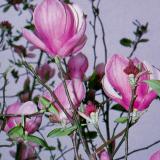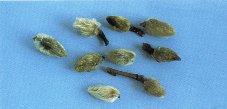Magnolia Flower
http://www.100md.com
《e Natural Health Center》
 |
 |
 |
Herbs for Dispelling Wind and Cold
Magnolia Flower
Latin:
Flos Magnoliae
Origin:
There are about 80 species of trees and shrubs Magnolia, of the family Magnoliaceae; native to North and Central America, the Himalayas, and eastern Asia. They are valued for their large and fragrant white, yellow, pink, or purple flowers and frequently handsome leaves and conelike fruits. Some are important garden ornamentals; others are local timber sources; and in the hands of the Chinese, some are used as decongestant herbs.
, 百拇医药
They have evergreen or deciduous, alternate smooth-margined leaves. The flowers, usually cuplike and fragrant, are located at the branch tips and have three sepals, 6 to 12 petals arranged in two to four series, and many spirally arranged stamens. The numerous simple ovaries in the centre later form a conelike fruit. The seeds, usually reddish, often hang pendulously by slender threads.
A well-known Asian specie of the genus Magnolia is the machaka magnolia Iiliflora Desr., a four-metre shrubby tree that has purple blossoms with white interiors and brownish fruits. The bud of this tree is used by the Chinese as the herb here. It is mainly cultivated in Henan, Anhui, Sichuan and other provinces. The herb is collected in early spring when the bud is not in blossom, dried in the sun and cleared of stalks.
, 百拇医药
Properties:
Pungent in flavor, warm in nature, it is related to the lung and stomach channels.
Functions:
Pungent and warm for dispersion and aromatic for moving about, with its floating effect, the herb is good at dispersing pathogenic wind and clearing nasal passage. It is an important herb to treat rhinopharyngitis (inflammation of the nasopharynx) with turbid discharge.
, 百拇医药
Applications:
1. The herb is used in combination with dahurian angelica root, xanthium and other herbs for dispersing wind and clearing passage, to treat wind-cold type of rhinopharyngitis with turbid discharge, headache and nasal obstruction; and wit peppermint, xanthium and other herbs for dispersing wind-heat, clearing passage and relieving pain, to treat wind-heat type of rhinorrhea with turbid discharge and headache.
, 百拇医药
2. To treat wind-cold affected by exopathogens, headache and nasal obstruction, the herb is used in combination with ledebouriella root, dahurian angelic root and other herbs for dispersing wind-cold.
Dosage and Administration:
3-10 g.
Wrapped in a gauze for decoction.
Cautions on Use:
Reference Materials:
, 百拇医药
Toxic or Side Effects:
Modern Researches:
With its astringing effect, magnolia flower can protect nasal mucosa and alleviate inflammation. Its infusion or decoction has the effect of inflamation anesthesia. Its extract with water has the effect of lowering blood pressure. Its decoction can excite uterine smooth muscle, promote intestinal movement and inhibit various kinds of pathogenic bacteria. Its volatile oil have sedative and analgesic effects., http://www.100md.com